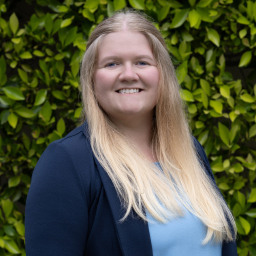Biomechanics of Women’s Health

Growing up, Megan Routzong, Ph.D., watched her mother play a critical role in health care – the nurse.
While her mother’s journey was inspiring and Dr. Routzong desired a career in a medicine, she knew her own path would deviate from her mother’s example.

“I actually witnessed her save a life,” she said. “Though I didn’t particularly like the hands-on pressure of having a life in your hands.”
Dr. Routzong excelled in math and physics during high school, which helped her solidify her college plans. She only applied to colleges accredited in biomedical engineering.
Under the direction of her advisor, Amy Lerner, Ph.D., Dr. Routzong began working on her first research project which involved computational biomechanics of the knee. By the end of her undergraduate career, she was designing an independent study course on finite element models, a way of simulating biomechanics at the tissue level.
Inspired by the independent study course, Dr. Routzong began looking for doctorate programs that would allow her to continue applying that type of modeling. She was directly accepted into the University of Pittsburgh by Professor Steven Abramowitch, Ph.D., who was seeking to develop a finite element model of vaginal childbirth.
Dr. Routzong began researching the effect of pregnancy on skeletal muscles and connective tissues of the female pelvic floor. The subject matter was inspiring enough that she continued her research throughout her postdoctoral training with Marianna Alperin, M.D., M.S., at the University of California, San Diego.
“Looking at pregnancy and childbirth is too important and too meaningful, and I don’t think I can stop doing it,” she said. “I wasn’t convinced there was someone else that would do the same research in a reasonable amount of time.”
While the research topic remained the same during Dr. Routzong’s postdoc program, she expanded her skillsets and new ways to conduct her research. Focusing more on the wet lab, she learned cell culture techniques to study mechanobiology as well.
“I was still looking at pelvic floor muscles during pregnancy, just through very different lenses,” she said.
As an Assistant Professor in UT Southwestern’s Department of Biomedical Engineering, Dr. Routzong will continue her translational research in women’s health-related biomechanics and mechanobiology.
“I knew the best fit for me would be a place where I can be very well integrated in the clinical side of things to get data and feedback,” she said. “But it was the environment, the people and the opportunity for collaborations that helped me choose UT Southwestern.”
Collaboration is at the top of Dr. Routzong’s priority list as she builds a brand-new lab focused on computational modeling and experiments researching musculoskeletal tissues related to women’s health. While her lab will continue the research she has already started surrounding pregnancy and childbirth, she also hopes to expand into pelvic floor muscle conditions that are hormone sensitive, like menopause.
“I want to do computational work, but also physical experiments in both biomechanics and mechanobiology – incorporating both whole tissue scale and also sub tissue structure and cellular function,” she said.
Training the next generation of biomedical engineers will also be a priority for Dr. Routzong’s lab as she envisions how she would like to mentor students.
“If your lab is known for a specific technique and that means something to other researchers, then your students should leave your lab knowing how to do that technique,” she said.
